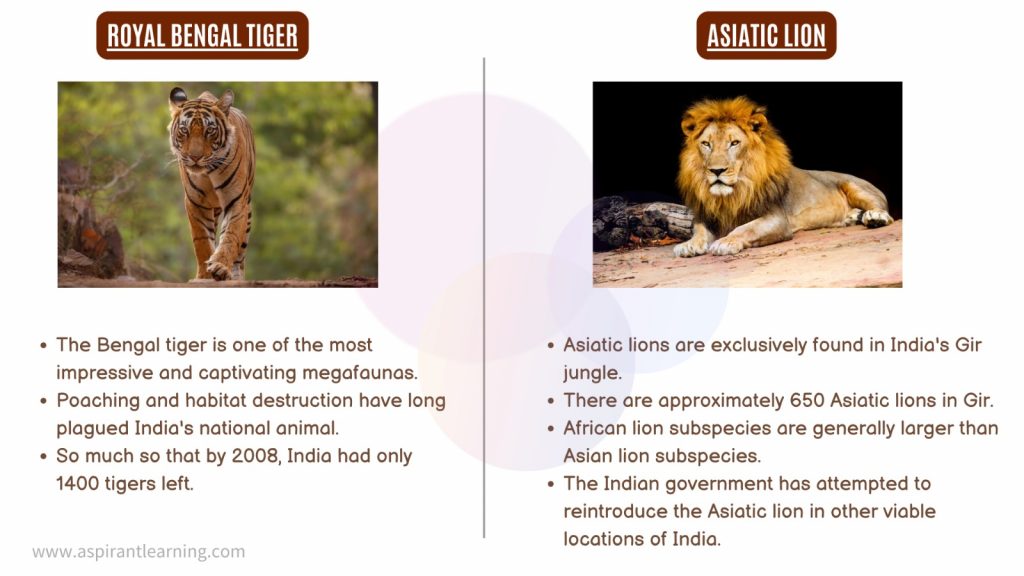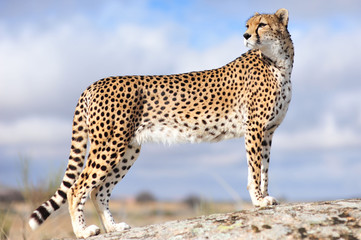News Highlight
A megafauna bias in India’s carnivore research is hampering the country’s conservation efforts.
Key Takeaway
- Carnivore research in India is overly focused on more prominent species, resulting in a lack of awareness of smaller and lesser-known predators.
- This knowledge gap is impeding conservation efforts in the country.
Importance of Carnivore Conservation
- Carnivores dominate the food web and play an important role in preserving ecological balance.
- Despite their importance, carnivores are among the world’s most endangered mammals.
- As a result, significant research and conservation resources are committed internationally to understanding, conserving, and managing carnivore populations.
India’s Carnivore Conservation Status
- Overview
- India is home to 23% of the world’s carnivore population, which includes 60 different species.
- A study of studies published since 1947 reveals that the influence of the country’s 70 years of research on charismatic species on their conservation status and policy has been inadequate.
- The country’s carnivore literature is dominated by the wild cat family, particularly the tiger.
- Other top carnivores receiving significant research attention are the Indian leopard, golden jackal, dhole, and jungle cat.
- Unfortunately, the overall quality of research on smaller and less charismatic carnivores has been weak.
Impact of Research on Carnivores in India
- Scientific studies on tigers resulted in the creation of Project Tiger in 1973, which aided in building 50 tiger reserves around the country.
- In litigation, research has presented evidence against the construction or development of roadways through tiger habitats such as;
- Bandipur Tiger Reserve, the Kanha-Pench Tiger Corridor, and the Bhagwan Mahavir Wildlife Sanctuary.
- The ambitious Ken-Betwa River interlinking project, which is expected to submerge a large chunk of the core region of Madhya Pradesh’s Panna Tiger Reserve, has been challenged by research findings.
- The study of the Indian leopard resulted in national recommendations for reducing human-leopard conflict.
- The country’s carnivore literature is dominated by the wild cat family, particularly the tiger.
- Other top carnivores that have attracted significant research attention include the Indian leopard, golden jackal, dhole, and jungle cat.
- However, research on smaller and less charismatic carnivores has been largely poor.
Charismatic Megafauna in India
- India has a diverse biome.
- It is one of 17 megadiverse countries on the planet.
- India is home to thousands of different animal species.
- On the other hand, some species are visually pleasing and easy to identify. Some species, such as the Royal Bengal Tiger, are known as charismatic megafaunas.
- Seven vulnerable species of India’s charismatic megafauna are discussed in this article.
- Threatened species are those that are on the verge of extinction and so require conservation efforts.
Challenges in Carnivore Research and Conservation in India
- Wetland and grassland ecosystem conservation remain low priorities.
- It provides sanctuary to highly endangered animals such as the caracal, which is also overlooked in research and protection.
- Natural history studies, the fundamental stepping stone to understanding species ecology, are declining.
- It is exacerbated by a fall in journals that publish such studies.
- Political factors and wrong priorities frequently influence policies, and scientific advice is ignored.
- Carnivore literature lacks integrative investigations.
- It impedes the formulation of socio-ecologically responsive policy.
- To help non-government organisations and independent researchers, bureaucratic barriers must be removed.

Way Forward
- Funding for studies into smaller and less charismatic carnivores has been increased to boost their profile.
- Additionally, India’s conservation policies emphasise their sensitive and threatened habitats.
- Multidisciplinary research using a collaborative and constructive approach that involves communities to promote socio-ecologically aware policy.
- Frameworks such as biodiversity heritage sites established under the Indian Biological Diversity Act (2002) or community reserves based under the Indian Wildlife Protection Act (1972).
- They aid in maintaining socio-ecological systems by encouraging local stewardship and, ultimately, democratising carnivore research.
Pic Courtesy: Down to Earth
Content Source: Down to Earth



